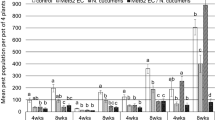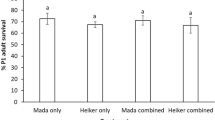Abstract
Many turf managers prefer to control foliage- and root-feeding pests with the same application, so-called multiple-targeting, using a single broad-spectrum insecticide or a premix product containing two or more active ingredients. We compared the impact of a neonicotinoid (clothianidin), a premix (clothianidin + bifenthrin), and an anthranilic diamide (chlorantraniliprole), the main insecticide classes used for multiple targeting, on four species of beneficial insects: Harpalus pennsylvanicus, an omnivorous ground beetle, Tiphia vernalis, an ectoparasitoid of scarab grubs, Copidosoma bakeri, a polyembryonic endoparasitoid of black cutworms, and Bombus impatiens, a native bumble bee. Ground beetles that ingested food treated with clothianidin or the premix suffered high mortality, as did C. bakeri wasps exposed to dry residues of those insecticides. Exposure to those insecticides on potted turf cores reduced parasitism by T. vernalis. Bumble bee colonies confined to forage on white clover (Trifolium repens L.) in weedy turf that had been treated with clothianidin or the premix had reduced numbers of workers, honey pots, and immature bees. Premix residues incapacitated H. pennsylvanicus and C. bakeri slightly faster than clothianidin alone, but otherwise we detected no synergistic or additive effects. Chlorantraniliprole had no apparent adverse effects on any of the beneficial species. Implications for controlling turf pests with least disruption of non-target invertebrates are discussed.


Similar content being viewed by others
References
Analytical Software (2009) Statistix user’s manual. Analytical Software, Tallahassee
Best RL, Beegle CC (1977) Food preferences of five species of carabids commonly found in Iowa cornfields. Environ Entomol 6:9–12
Bixby-Brosi AJ, Potter DA (2012a) Beneficial and innocuous invertebrates in turf. In: Brandenburg RL, Prater CA (eds) Handbook of turfgrass insect pests. Entomological Society of America, Lanham, pp 87–93
Bixby-Brosi AJ, Potter DA (2012b) Endophyte-mediated tritrophic interactions between a grass-feeding caterpillar and two parasitoid species with different life histories Arthropod-Plant Interact 6:27–34
Blacquière T, Smagghe G, van Gestel CAM, Mommaerts V (2012) Neonicotinoids in bees: a review on concentrations, side-effects and risk assessment. Ecotoxicology 21:973–992
Blaine TW, Clayton S, Robbins P, Grewal PS (2012) Homeowner attitudes and practices towards residential landscape management in Ohio, USA. Environ Manag 50:257–271
Brugger KE, Cole PG, Newman IC, Parker N, Scholtz B, Suvagia P, Walker G, Hammond TG (2010) Selectivity of chlorantraniliprole to parasitoid wasps. Pest Manag Sci 66:1075–1081
Buss E (2012) Pros and cons of pesticide combinations. Fla Pest Pro 2012:27–28
Byers JR, Yu DS, Jones W (1993) Parasitism of the army cutworm, Euxoa auxiliaris (Lepidoptera: Noctuidae), by Copidosoma bakeri (Howard) (Hymenoptera: Encyrtidae) and effect on crop damage. Can Entomol 125:329–335
Carpenter PJ, Meyer MH (1999) Edina goes green part I: a model for low-input lawn care community education. Hort Technol 9:486–489
Cherry R, Nagata R (2007) Resistance to two classes of insecticides in southern chinch bugs (Hemiptera: Lygaeidae). Fla Entomol 90:431–434
Cockfield SD, Potter DA (1983) Short-term effects of insecticidal applications on predaceous arthropods and oribatid mites in Kentucky bluegrass turf. Environ Entomol 12:1260–1264
Cockfield SD, Potter DA (1984) Predatory insects and spiders from suburban lawns in Lexington, Kentucky. Great Lakes Entomol 17:179–184
Cordova D, Benner EA, Sacher MD, Rauh JJ, Sopa JS, Lahm GP, Selby TP, Stevenson TM, Flexner L, Gutteridge S, Rhoades DF, Wu L, Smith RM, Tao Y (2006) Anthranilic diamides: a new class of insecticides with a novel mode of action, ryanodine receptor activation. Pestic Biochem Physiol 84:196–214
Dinter A, Brugger KE, Frost NM, Woodward MD (2009) Chlorantraniliprole (Rynaxypyr): a novel DuPont insecticide with low toxicity and low risk for honey bees (Apis mellifera) and bumblebees (Bombus terrestris) providing excellent tools for uses in integrated pest management. In: Oomen PA, Thompson HM (eds) Hazards of pesticides to bees—10th international symposium of the ICP-Bee Protection Group, Julius-Kühn-Archiv 423, Bucharest, pp 84–96
Dobson RG (2005) Sustainable golf courses: a guide to environmental stewardship. Wiley, New York
Elbert A, Haas M, Springer B, Thielert W, Nauen R (2008) Applied aspects of neonicotinoid uses in crop protection. Pest Manag Sci 64:1099–1105
Fleming WE (1968) Biological control of the Japanese beetle. US Department of Agriculture Technical Bulletin, Washington, DC
Gange AC, Lindsay DE, Schofield JM (2003) The ecology of golf courses. Biologist 50:63–68
Gels JA, Held DW, Potter DA (2002) Hazards of insecticides to bumble bees, Bombus impatiens (Hymenoptera: Apidae) foraging on flowering white clover in turf. J Econ Entomol 95:722–728
Gill RJ, Ramos-Rodriguez O, Raine NE (2012) Combined pesticide exposure severely affects individual- and colony-level traits in bees. Nature 491:105–109
Gradish AE, Scott-Dupree CD, Schipp L, Harris CR, Ferguson G (2010) Effect of reduced risk pesticides for use in greenhouse vegetable production on Bombus impatiens (Hymenoptera: Apidae). Pest Manag Sci 66:142–146
Held DW, Potter DA (2012) Prospects for managing turfgrass pests with reduced chemical inputs. Annu Rev Entomol 57:329–354
Houseworth LD (2009) Innovations in turf insect pest management. Lawn & Landscape 30:1–3
Kenna MP, Snow JT (2000) The US golf association turfgrass and environmental research program overview. In: Clark JM, Kenna MP (eds) Fate and management of turfgrass chemicals. American Chemical Society Symposium Series 743. American Chemical Society, Washington, DC, pp 2–35
Kirk VM (1973) Biology of a ground beetle, Harpalus pennsylvanicus. Ann Entomol Soc Am 66:513–518
Kostromytska OS, Buss EA, Scharf ME (2011) Toxicity and neurophysiological effects of selected insecticides on the mole cricket, Scapteriscus vicinus (Orthoptera: Gryllotalpidae). Pestic Biochem Physiol 100:27–34
Kunkel BA, Held DW, Potter DA (1999) Impact of halofenozide, imidacloprid, and bendiocarb on beneficial invertebrates and predatory activity in turfgrass. J Econ Entomol 92:922–930
Kunkel BA, Held DW, Potter DA (2001) Lethal and sublethal effects of bendiocarb, halofenozide, and imidacloprid on Harpalus pennsylvanicus (Coleoptera: Carabidae) following different modes of exposure in turfgrass. J Econ Entomol 94:60–67
Lahm GP, Stevenson TM, Selby TP, Freudenberger JH, Dubas CM, Smith BH et al (2007) Rynaxypyr: a new anthranilic diamide insecticide acting at the rynanodine receptor. In: Ohkawa H, Miyagawa H, Lee PW (eds) Pesticide chemistry crop protection, public health, and environmental safety. Wiley, Weinheim, pp 111–120
Larson JL, Redmond CT, Potter DA (2012) Comparative impact of an anthranilic diamide and other insecticidal chemistries on beneficial invertebrates and ecosystem services in turfgrass. Pest Manag Sci 68:740–748
Larson JL, Redmond CT, Potter DA (2013) Assessing insecticide hazard to bumble bees foraging on flowering weeds in treated lawns. PLoS One 8(6):e66375. doi:10.1371/journal.pone.0066375
Lee ET (1992) Statistical methods for survival data analysis, 2nd edn. Wiley, New York
Liu F, Zhang X, Gui QQ, Xu QJ (2012) Sublethal effects of four insecticides on Anagrus nilaparvatae (Hymenoptera: Mymaridae), an important egg parasitoid of the rice planthopper Nilaparvata lugens (Homoptera: Delphacidae). Crop Prot 37:13–19
López R, Potter DA (2000) Ant predation on eggs and larvae of the black cutworm (Lepidoptera: Noctuidae) and Japanese beetle (Coleoptera: Scarabidae) in turfgrass. Environ Entomol 29:116–125
Oliver JB, Reding ME, Moyseenko JJ, Klein MG, Mannion CM, Bishop B (2006) Survival of adult Tiphia vernalis (Hymenoptera: Tiphiidae) after insecticide, fungicide, and herbicide exposure in laboratory bioassays. J Econ Entomol 99:288–294
Peck DC (2009) Long-term effects of imidacloprid on the abundance of surface- and soil-active nontarget fauna in turf. Agric For Entomol 11:405–419
Potter DA (1993) Pesticide and fertilizer effects on beneficial invertebrates and consequences for thatch degradation and pest outbreaks in turfgrass. In: Racke KD, Leslie AR (eds) Pesticides in urban environments. Fate and significance, ACS Symposium Series 522. American Chemical Society, Washington, DC, pp 331–343
Potter DA, Held DW (2000) Biology and management of the Japanese beetle. Annu Rev Entomol 47:175–205
Potter DA, Buxton MC, Redmond CT, Patterson CG, Powell AJ (1990) Toxicity of pesticides to earthworms and effect on thatch degradation in Kentucky bluegrass turf. J Econ Entomol 83:2362–2369
Racke K (2000) Pesticides for turfgrass pest management: uses and environmental issues. In: Clark JM, Kenna MP (eds) Fate and management of turfgrass chemicals, ACS Symposium Series 743. American Chemical Society, Washington, DC, pp 45–64
Ramoutar D, Alm SR, Cowles RS (2009) Pyrethroid resistance in populations of Listronotus maculicollis Kirby (Coleoptera: Curculionidae) from southern New England golf courses. J Econ Entomol 102:388–392
Rogers ME, Potter DA (2003) Effects of spring imidacloprid application for white grub control on parasitism of Japanese beetle (Coleoptera: Scarabaeidae) by Tiphia vernalis (Hymenoptera: Tiphiidae). J Econ Entomol 96:1412–1419
Saeki Y, Crowley PH, Fox CW, Potter DA (2009) A sex-specific tradeoff in clonal broods. Oikos 188:1552–1560
Schaaf AC (1972) The parasitoid complex of Euxoa ochrogaster (Guenee) (Lepidoptera: Noctuidae). Quaest Entomol 8:81–120
Shepherd MD, Tepedino VJ (2000) The birdies and the bees: native pollinators on your golf course. US Golf Assoc Green Sec Rec 38(4):17–21
Terman MR (1997) Natural links: naturalistic golf courses as wildlife habitat. Landsc Urban Plan 38:183–197
Terry LA, Potter DA, Spicer PG (1993) Insecticides affect predatory arthropods and predation on Japanese Beetle (Coleoptera: Scarabaeidae) eggs and fall armyworm (Lepidoptera: Noctuidae) pupae in turfgrass. J Econ Entomol 86:871–878
Vittum PJ, Villani MG, Tashiro H (1999) Turfgrass insects of the United States and Canada. Cornell University Press, Ithaca, p 422
Wang J, Yanqing HZ, Zhu Y, Xie Z et al (2012) Molecular characterization of a ryanodine receptor gene in the rice leaffolder, Cnaphalocrocis medinalis (Guenée). PLoS One 7(5):e36623. doi:10.1371/journal.pone.0036623
Williamson CR, Potter DA (1997) Nocturnal activity and movement of black cutworms (Lepidoptera: Noctuidae) and response to cultural manipulations on golf course putting greens. J Econ Entomol 90:1283–1289
Zenger JT, Gibb TJ (2001) Impact of four insecticides on Japanese beetle (Coleoptera: Scarabaeidae) egg predators and white grubs in turfgrass. J Econ Entomol 94:145–149
Acknowledgments
The authors thank A. J. Bixby-Brosi and David Williams for technical advice, E. K. Dobbs, A. J. Kesheimer, and A. A. Larson for field assistance and Ricardo Bessin for statistical advice. This work was supported in part by a grant from the United States Golf Association, and by the B.C. Pass Graduate Fellowship. This is paper number 13-08-018 of the Kentucky Agricultural Experiment Station. All experiments were conducted according to the rules and regulations of the University of Kentucky and the United States of America.
Conflict of interest
The authors declare they have no conflict of interest.
Author information
Authors and Affiliations
Corresponding author
Rights and permissions
About this article
Cite this article
Larson, J.L., Redmond, C.T. & Potter, D.A. Impacts of a neonicotinoid, neonicotinoid–pyrethroid premix, and anthranilic diamide insecticide on four species of turf-inhabiting beneficial insects. Ecotoxicology 23, 252–259 (2014). https://doi.org/10.1007/s10646-013-1168-4
Accepted:
Published:
Issue Date:
DOI: https://doi.org/10.1007/s10646-013-1168-4




